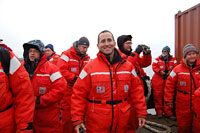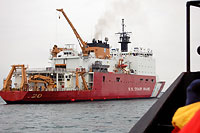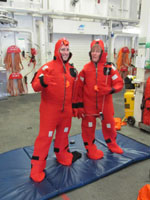

 | |||||||||||||
|
|
Journals 2009/2010Jonathan Pazol
August 7, 2009 When we went to sleep last night, there was no way of knowing how everyone was going to get to the Healy because the helicopter was still stranded in Fairbanks. There was talk that the helicopter would arrive late on Friday and that some of the more necessary personnel (people running the computer systems and the early experiments) would board, while those of us less-vital people (teachers, lawyers, etc.) might not even board until Saturday. Another issue was that the cargo plane, carrying over 4000 pounds of fresh food for the ship, could not make the trip either. One of the Coast Guard logistics officers was also talking about using a barge/landing craft that was anchored near the beach, but because this had not been tried before, nobody thought it would be possible. At breakfast, we got word that the helicopter still was still stranded, but that the large landing craft owned by the Bowhead Transportation Company (a subsidiary of Ukpeagvik Inupiat Corporation) could carry all of us and our equipment to the Healy after picking up the outgoing crew. Still, none of this was confirmed. Our plane-full of fresh food had not arrived, and no one knew how that would be solved. Then, because "it's the Arctic," we got word to quickly pack our bags and be ready to head out to the beach to take the landing craft. While waiting by the beach, we took a quick trip over to the blue AstroTurf field of the Barrow High School Whalers football team - they have to fly to away games, and while there heard the sound of the cargo plane landing at the nearby airport. It seemed like everything was actually going to come together. The trucks with our food pulled up, the landing craft left the Healy, the workers from Bowhead bulldozed a ramp on the beach, the outgoing crew got off, we got on and put on Mustang safety suits (I could be a stand-in for the Michelin Man), they loaded our fresh food, and we were on our way. Good-bye dry land. I'll see you in about 6 weeks.
The Healy was anchored about a mile off shore, and from there it did not look very big. As we approached closer and closer, I realized how impressive the ship actually is. There are four stories above the main deck and the bridge with the tower called the Aloft Conn above that. There are several cranes, lifts, a helicopter bay with room for two helicopters, a landing craft and RHIB (Rigid Hull Inflatable Boat) hanging on the sides. The barge pulled up alongside the Healy, and they used a crane to lower the gangplank. We climbed up and went aboard.
Once on the ship, we found our rooms and began to unpack. My roommate is John Hall, a geophysicist from the Geographic Survey of Israel in Jerusalem. He, like everyone else I have met so far, has some impressive experiences and significant expertise to bring to the trip. I am really looking forward to learning all I can from them. We had an orientation meeting, dinner, and then had an evacuation drill. For the second time in one day, I was once again going to make a fashion statement. This time, we practiced getting into neoprene safety suits (affectionately called "Gumby" suits because they make you look like the character from the old children's TV show). They insulate you from the cold water and have a whistle, mirror, and strobe light for signaling for a rescue. The crew members helped us and demonstrated how to get in them quickly and also the other procedures to follow in case we had to "abandon ship." Like fire drills in school, this type of practice is critically important should an actual emergency arise.
For the rest of the evening, the ship sailed toward our first project, recovery of an acoustic mooring, which had been in the water for a year recording the noises of the ocean. |
||||||||||||


